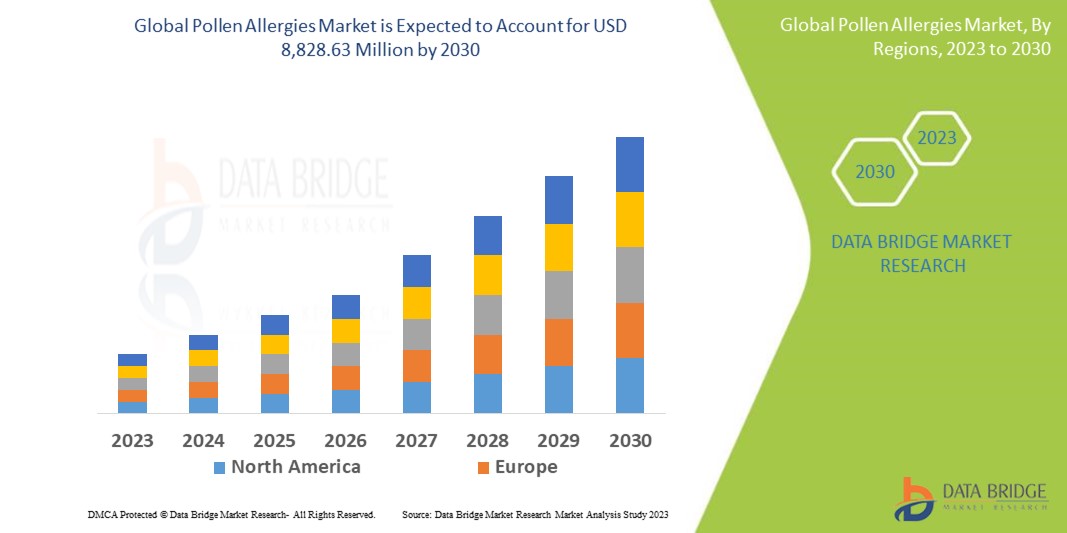
Pollen Allergies Market Trends 2025 - 2032 | Challenges and Opportunities with Top Countries Data
The Pollen Allergies Market is entering a transformative phase, with forecasts predicting strong growth and groundbreaking innovations by 2032. Driven by rising demand, digital adoption, and evolving consumer needs, the industry is rapidly expanding across global markets. A recent report highlights key drivers such as increasing market share, advanced segmentation, and the growing influence of tech-enabled solutions.
Backed by tools like SWOT and PESTEL analysis, the study explores economic, regulatory, and technological forces shaping the market’s future. With platforms like NUCLEUS Connected Intelligence offering real-time insights and data-driven strategies, businesses and investors are better equipped to navigate challenges, seize new opportunities, and gain a competitive edge in this evolving landscape.
DataBridge Market Research has newly launched the NUCLEUS Platform, a Cloud-Connected Intelligence Platform that allows users to analyze and integrate macro and micro-level data seamlessly. This revolutionary tool bridges the gap between data analytics, market research, and strategy, providing businesses with a fully automated, Interactive Dashboard with Real Time Updates throughout the Year to drive profound growth and revenue impact.

What is the projected market size & growth rate of the Pollen Allergies Market?
Market Analysis and Size
Major factors that are expected to boost the growth of the pollen allergies market in the forecast period are the rapid urbanization in the advancing countries. Furthermore, the increase in greenhouse gas can result in pollen-induced reparative disease, which is further estimated to cushion the growth of the pollen allergies market. In addition, the increase in environmental pollution will further provide opportunities for the growth of the pollen allergies market in the coming years.
Data Bridge Market Research analyses that the global pollen allergies market which was USD 5,850.84 million in 2022, would rocket up to USD 8,828.63 million by 2030 and is expected to undergo a CAGR of 4.2% during the forecast period. “Instruments” dominates the product segment of the market owing to the high demand for this type of product.
In addition to the insights on market scenarios such as market value, growth rate, segmentation, geographical coverage, and major players, the market reports curated by the Data Bridge Market Research also include depth expert analysis, patient epidemiology, pipeline analysis, pricing analysis, and regulatory framework.
Browse Detailed TOC, Tables and Figures with Charts which is spread across 350 Pages that provides exclusive data, information, vital statistics, trends, and competitive landscape details in this niche sector.
This research report is the result of an extensive primary and secondary research effort into the Pollen Allergies market. It provides a thorough overview of the market's current and future objectives, along with a competitive analysis of the industry, broken down by application, type and regional trends. It also provides a dashboard overview of the past and present performance of leading companies. A variety of methodologies and analyses are used in the research to ensure accurate and comprehensive information about the Pollen Allergies Market.
Get a Sample PDF of Report - https://www.databridgemarketresearch.com/request-a-sample/?dbmr=global-pollen-allergies-market
Which are the driving factors of the Pollen Allergies market?
The driving factors of the Pollen Allergies market include technological advancements that enhance product efficiency and user experience, increasing consumer demand driven by changing lifestyle preferences, and favorable government regulations and policies that support market growth. Additionally, rising investment in research and development and the expanding application scope of Pollen Allergies across various industries further propel market expansion.
Pollen Allergies Market - Competitive and Segmentation Analysis:
Global Pollen Allergies Market, By Product (Instruments, Consumables, and Services), Allergen Type (Food, Inhaled, Drug, and Others), Diagnostics Test (In Vivo Test and In Vitro Test), Therapeutics Drug Class (Antihistamines, Decongestants, Corticosteroids, Mast Cell Stabilizers, Leukotriene Inhibitor, Nasal Anticholinergics, Immunomodulators, Auto injectable Epinephrine, and Immunotherapy), End User (Diagnostic Laboratories, Hospitals, and Academic Research Institutes) – Industry Trends and Forecast to 2032.
How do you determine the list of the key players included in the report?
With the aim of clearly revealing the competitive situation of the industry, we concretely analyze not only the leading enterprises that have a voice on a global scale, but also the regional small and medium-sized companies that play key roles and have plenty of potential growth.